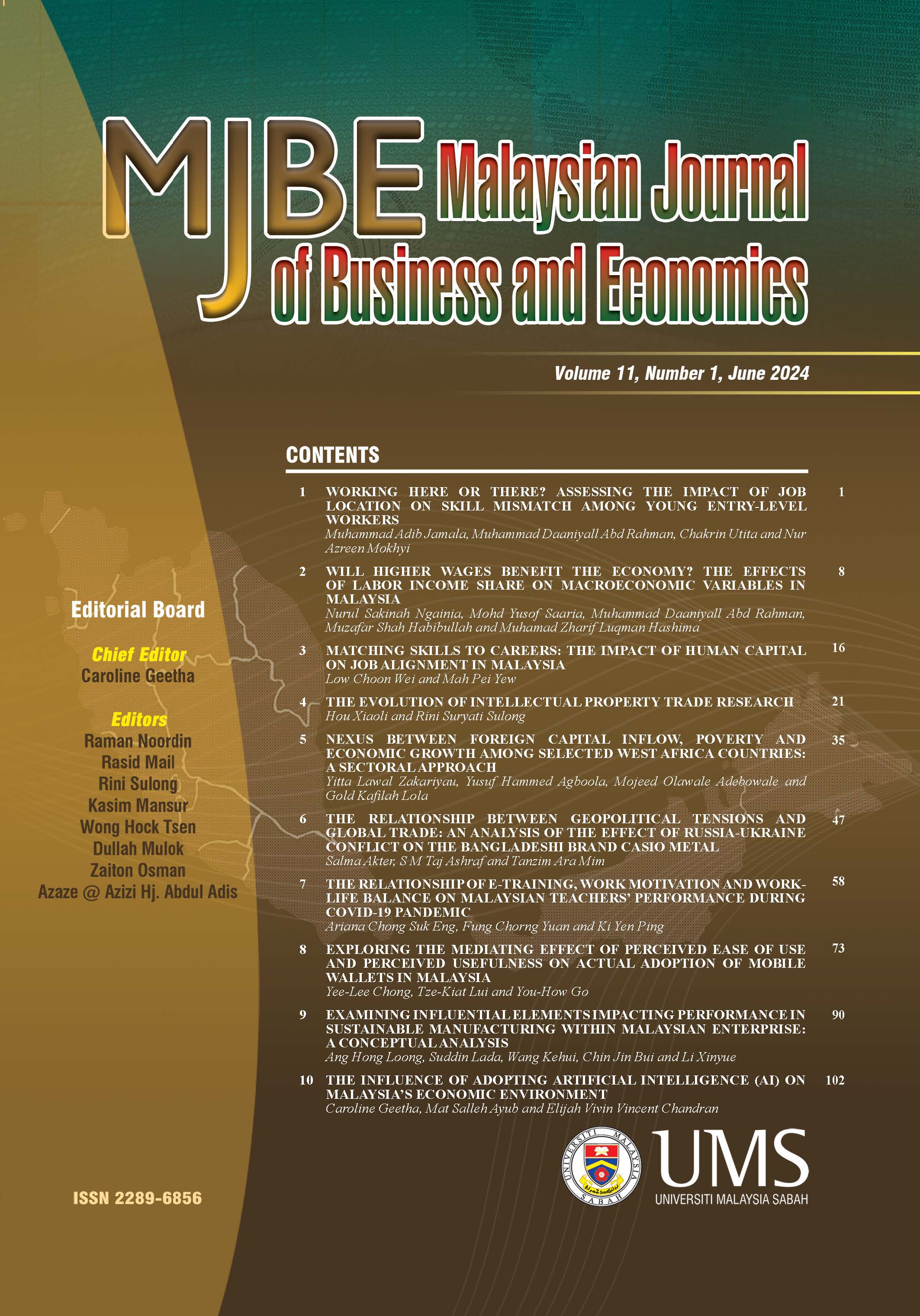THE INFLUENCE OF ADOPTING ARTIFICIAL INTELLIGENCE (AI) ON MALAYSIA'S ECONOMIC ENVIRONMENT.
DOI:
https://doi.org/10.51200/mjbe.v11i1.5294Keywords:
artificial intelligence, economic landscape, Malaysia, microeconomics, macroeconomicsAbstract
This study aims to conduct a systematic review of the implications of adopting Artificial Intelligence (AI) on the economic landscape of Malaysia. Aligned with economic growth theories, the research underscores AI's pivotal role in transforming resources characterized by diminishing marginal returns into assets with increasing marginal returns. The analysis is multifaceted, addressing three fundamental perspectives. First, it examines AI adoption's impact on both microeconomic and macroeconomic dimensions. At the macroeconomic level, the study observes AI's influence on demand-pull and cost-push inflation, affecting overall price levels in the Malaysian economy. At the microeconomic level, AI adoption is linked to increased productivity and efficient resource allocation, leading to economies of scale. In an innovative and competitive business environment, AI adoption further enhances the quality of goods and services while ensuring competitive pricing strategies. Second, the study differentiates the positive and negative consequences of AI adoption across various sectors and demographic groups, providing specific examples of how different industries and population segments may benefit from or face challenges due to AI implementation. Finally, the analysis distinguishes the short-term and long-term impacts of AI adoption. In the short term, changes in employment, productivity, and consumer prices are identified, while the long-term analysis explores structural changes, including income redistribution and sustained productivity growth. The findings highlight the net positive impact of AI adoption in Malaysia, emphasizing that its benefits outweigh the costs. The study underscores the significance of government involvement in formulating policies and providing necessary infrastructure, aligning with Romer's theory of economic growth to drive successful and sustainable AI adoption for economic development.
References
Barro, R. (1997). Determinants of Economic Growth: A Cross-Country Empirical Study. MIT
Press.
Colleen Christison. (2022). Using Social Media in Education: 8 Can’t-Miss Tips. https://blog.hootsuite.com/social-media-in-education.
Cosette Goldstein & Alison Chi. ( February 1, 2022). A Chatbot in the Crowd. How to build a time-saving bot for a multi-topic community forum?, Capital One Tech. https://www.capitalone.com/tech/machine-learning/chatbot-in-the-crowd.
Economic Planning Unit. (2022). National 4th Industrial Revolution Policy, Prime Minister Department.
Ed Burns, Nicole Laskowski & Linda Tucci. (July, 2023). What is AI? How does it work?,https://www.techtarget.com/searchenterpriseai/definition/AI-Artificial-Intelligence.
Federation of Malaysian Manufacturers. (December 4, 2021). FMM: M'sia needs to replenish over 600,000 foreign workers by 2022 to overcome current acute manpower shortage that could derail its economic recovery. https://www.fmm.org.my/FMM_In_The_News-@-FMM-;_M'sia_needs_to_replenish_over_600,000_foreign_workers_by_2022_to_overcome_current_acute_manpower_shortage_that_could_derail_its_economic_recovery.aspx.
Gilis, S. Alexander, & Culverhouse, Tim. (2014). https://www.techtarget.com/searchaws/definition/Amazon AI#:~:text=Amazon%20AI%20services%20integrate%20with,experience%20and%20business%20metrics%20improvement.
Hannah Unkefer. (June 21, 2017). Accenture Report: Artificial Intelligence Has Potential to Increase Corporate Profitability in 16 Industries by an Average of 38 Percent by 2035. https://newsroom.accenture.com/news/accenture-report-artificial-intelligence-has-potential-to-increase-corporate-profitability-in-16-industries-by-an-average-of-38-percent-by-2035.htm
Ipsos. (12 March, 2018). Malaysians Confident About Current Data Protection Measures. https://www.ipsos.com/en-my/malaysians-confident-about-current-data-protection- measures.
Iylia Marsya Iskandar, Aliza Shah. (News Strait Times, February 16, 2023). Employers doubt govt's aim to solve labour shortage issue in 3 months. https://www.nst.com.my/news/nation/2023/02/880350/employers-doubt-govts-aim-solve-labour-shortage-issue-3 months#google_vigne.
Julien Bouset, Brian Gregg, Kathryn Rathjie, Eli Stein & Kai Volhardt. (July 18, 2019). The future of personalization—and how to get ready for it. https://www.mckinsey.com/capabilities/growth-marketing-and-sales/our-insights/the-future-of-personalization-and-how-to-get-ready-for-it.
Kemal Güler & Abdulkadir Tepecik. Exchange Rates’ Change by Using Economic Data with Artificial Intelligence and Forecasting the Crisis, Procedia Computer Science 158:316-326. DOI:10.1016/j.procs.2019.09.057.
PwC. (2017). Sizing the prize. What’s the real value of AI for your business and how can you capitalise?.https://www.pwc.com/gx/en/issues/data-and-analytics/publications/artificial-intelligence-study.html.
Mc Clean, Toby. (2020). Building Economics of Scale in Artificial Intelligence, https://www.forbes.com/sites/forbestechcouncil/2020/07/27/building-economies-of-scale-in-artificial-intelligence.
Malaysian Digital Economic Corporation (MDEC). (2022). Southeast Asia. Digital Content Industry Talent Report. Talent Corporation.
Natalia Norori, Qiyang Hu, Florence Marcelle Aellen, Francesca Dalia Faraci, and Athina Tzovara. (2019). Addressing bias in big data and AI for health care: A call for open science, Patterns (N Y). 2021 Oct 8; 2(10): 100347. Published online 2021 Oct 8. doi: 10.1016/j.patter.2021.100347.
Simpasa & Gurara. (2012). Inflation Dynamics in selected East African countries: Ethiopia, Kenya,Tanzania and Uganda, African Development Bank Brief.
Startup Genome. (2022). The Global Startup Ecosystem Report 2022, Global Startup Ecosystem Ranking 2022 (Top 30+ Runners-up). https://startupgenome.com/article/global-startup-ecosystem-ranking-2022-top-30-plus-runners-up.
Statista. (2023). Malaysia Unemployment Rate From 1999 to 2022. https://www.statista.com/statistics/319019/unemployment-rate-in-malaysia.
Taherdoost, H. (2018) A Review of Technology Acceptance and Adoption Models and Theories. Procedia Manufacturing, 22, 960-967. https://doi.org/10.1016/j.promfg.2018.03.137.
Telenor Group. (2021). Human vs. Chatbot in the customer service game, https://www.telenor.com/stories/advance/human-vs-chatbot-in-the-customer-service-game/.
The Edge Malaysia. (19 May, 2023). Malaysians see AI as a hope for productivity more than a job threat. https://www.mida.gov.my/mida-news/malaysians-see-ai-as-a-hope-for-productivity-more-than-a-job-threat.
World Economic Forum,. (15th July, 2023). Centre for the Fourth Industrial Revolution Malaysia to Accelerate Green Transition, Digital Transformation. https://www.weforum.org/press/2023/05/centre-for-the-fourth-industrial-revolution-malaysia-to-accelerate-green-transition-digital-transformation/.
Downloads
Published
Versions
- 30-06-2024 (2)
- 30-06-2024 (1)
How to Cite
Issue
Section
License

CCBY (Attribution)
https://creativecommons.org/licenses/by/4.0/
© Universiti Malaysia Sabah 2025
All rights reserved. No part of this publication may be reproduced, distributed, stored in a database or retrieval system, or transmitted, in any form or by any means, electronic, mechanical, graphic, recording or otherwise, without the prior written permission of Universiti Malaysia Sabah Press, except as permitted by Act 332, Malaysian Copyright Act of 1987. Permission of rights is subjected to the journal.









